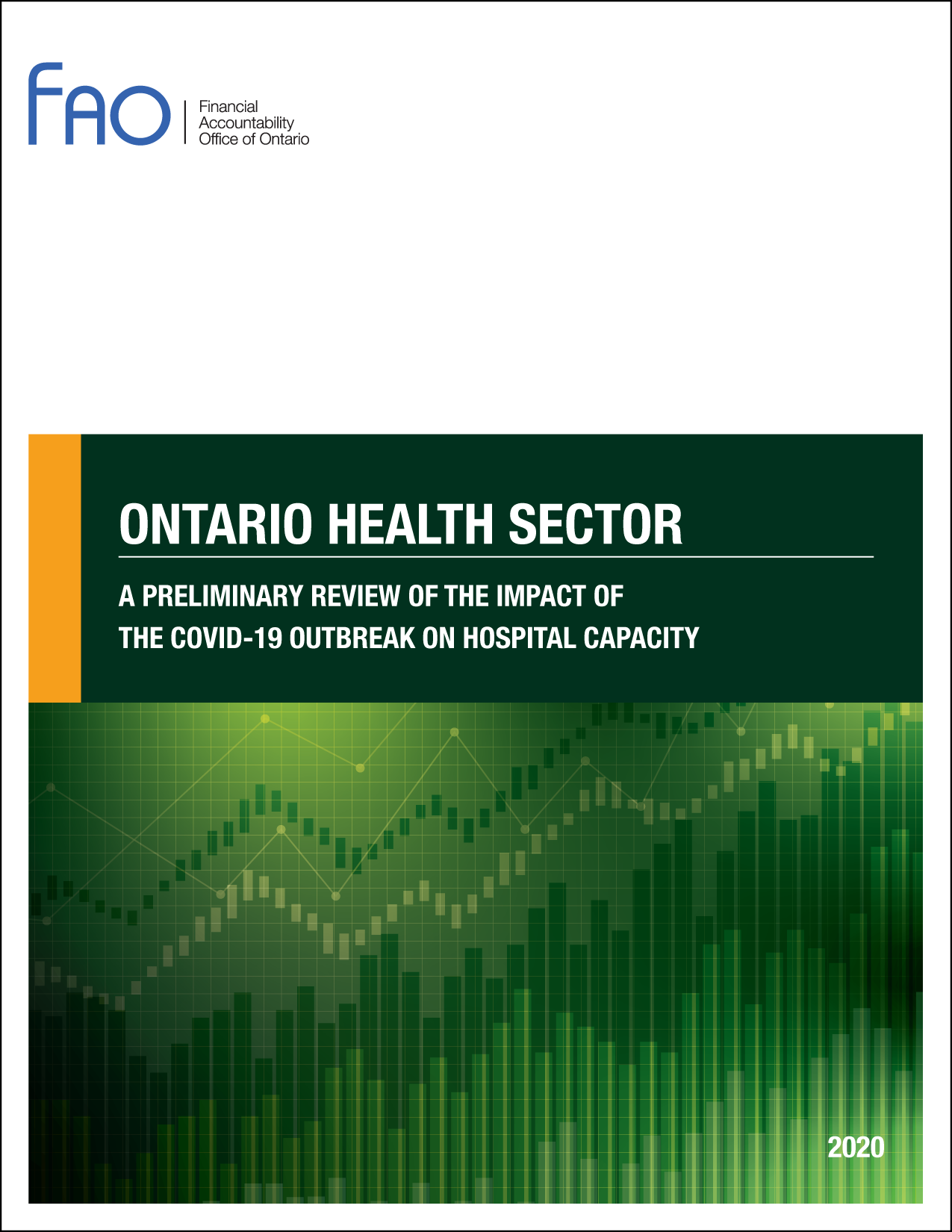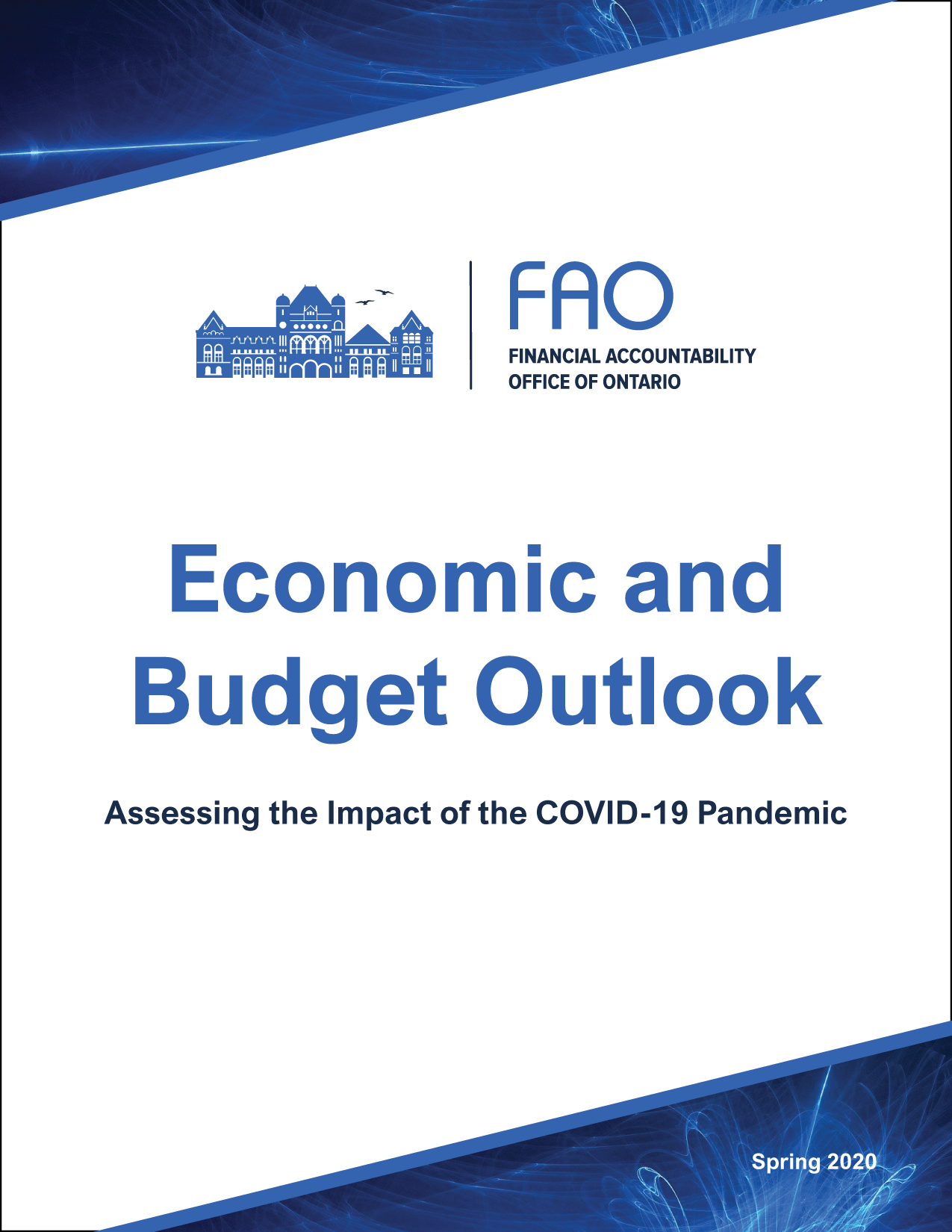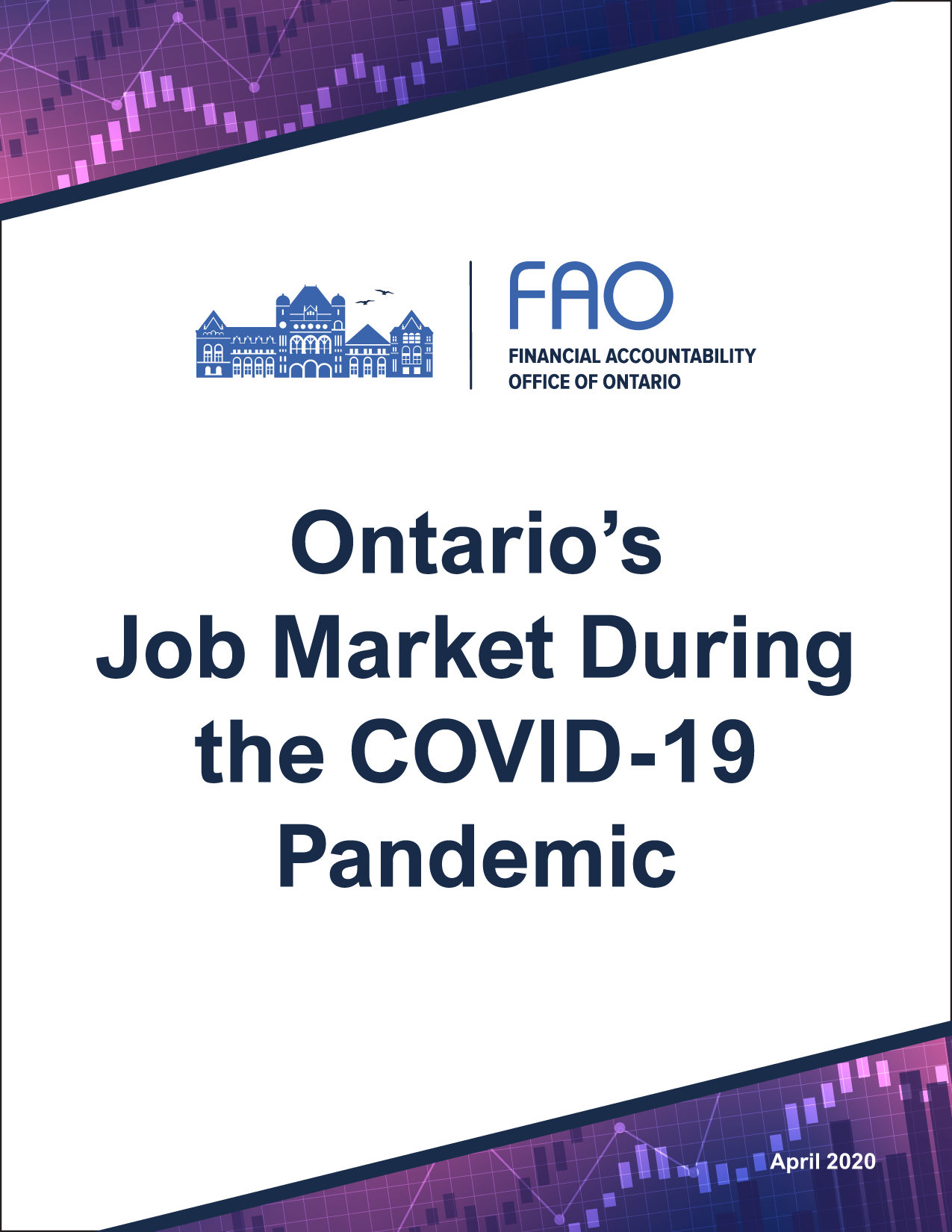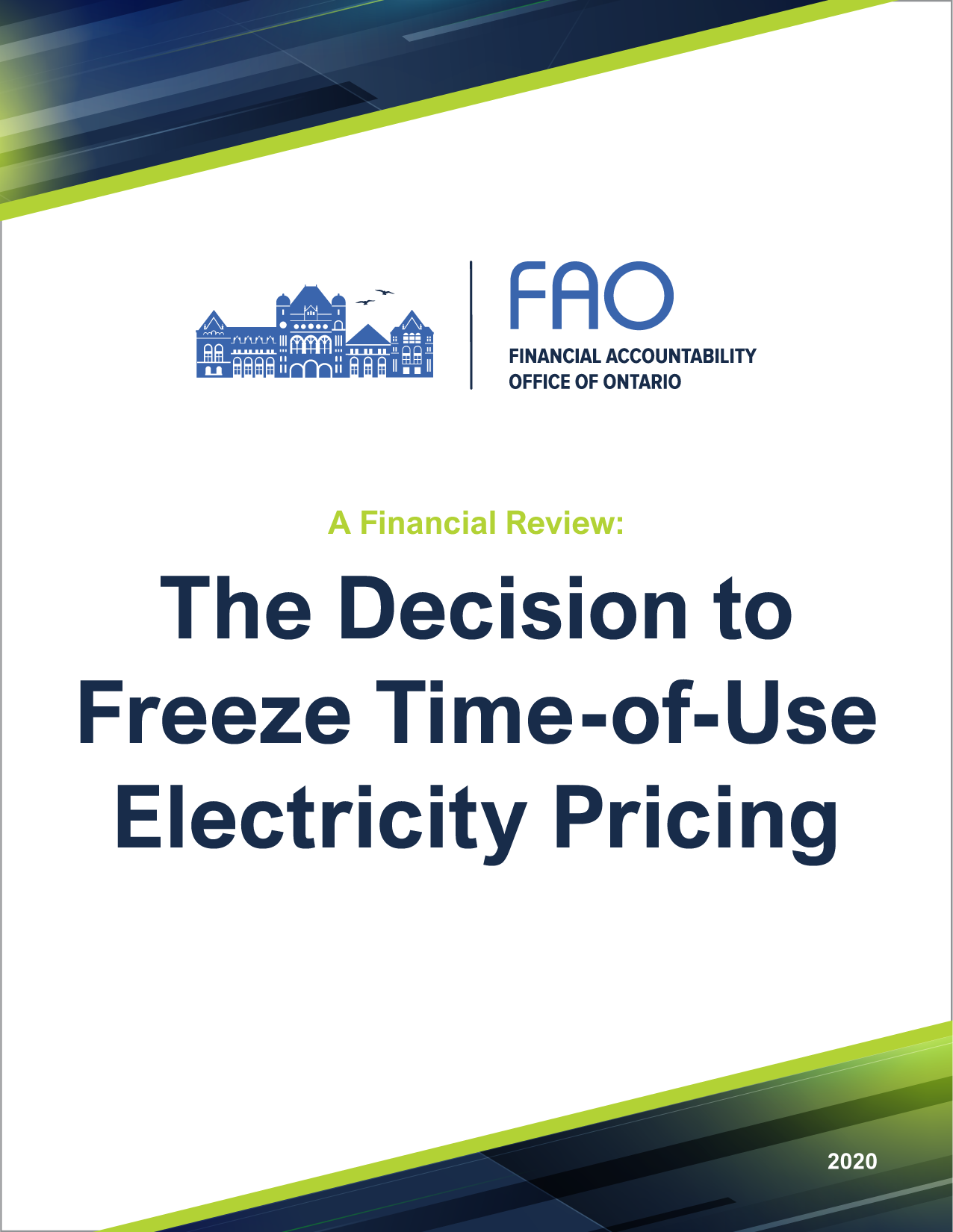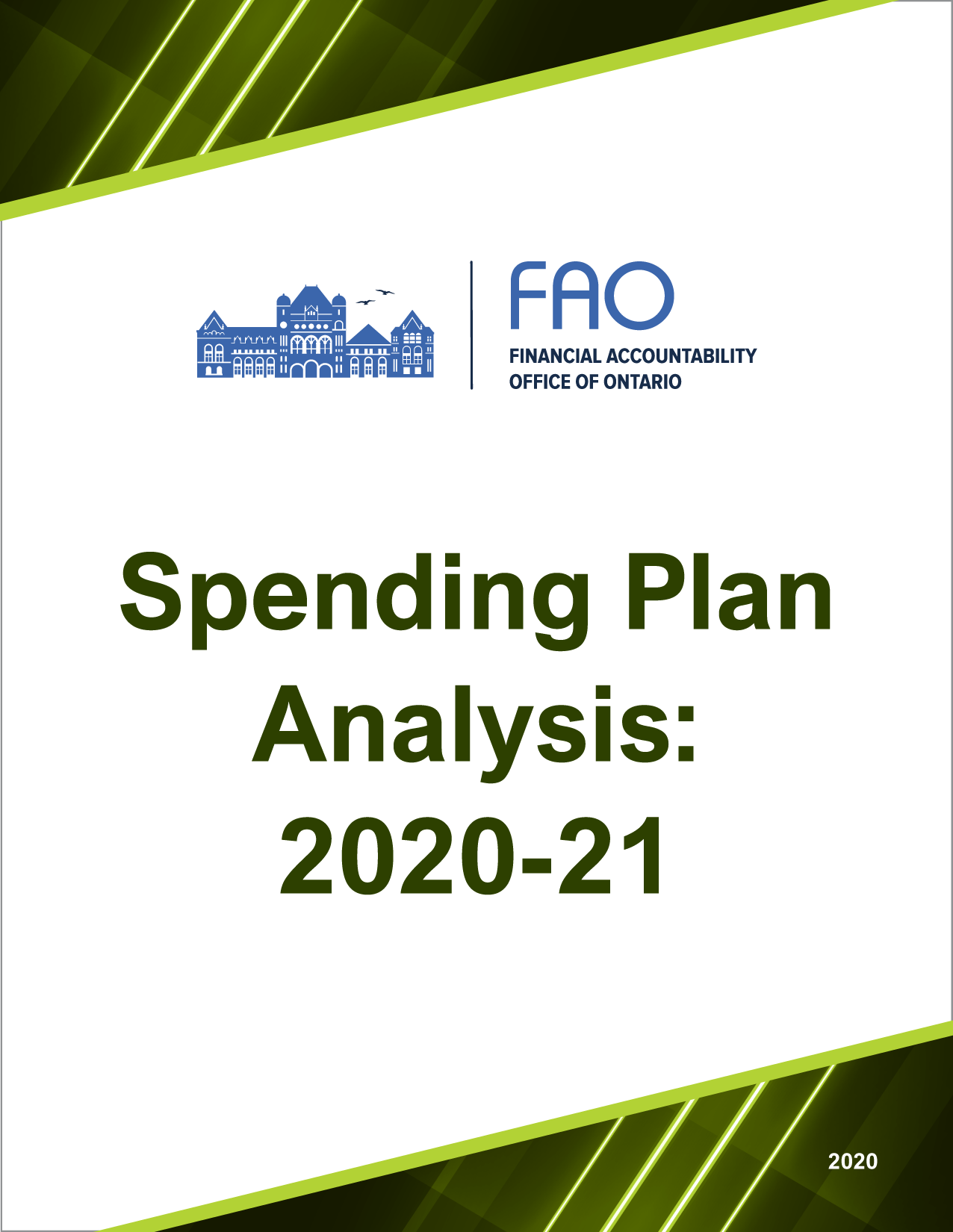
July 14, 2021
The Honourable Ted Arnott
Speaker of the Legislative Assembly of Ontario
Main Legislative Building, Room 180
Queen’s Park
Toronto, Ontario
M7A 1A2
Dear Mr. Speaker: In accordance with section 14 of the Financial Accountability Officer Act, 2013, I am pleased to present the 2020–21 Annual Report of the Financial Accountability Officer for your submission to the Legislative Assembly at the earliest reasonable opportunity.
Sincerely,
 Peter Weltman
Peter Weltman
Financial Accountability Officer
Officer’s Note
If you are reading this report, chances are that you are a citizen of Ontario who is deeply interested in how the Province of Ontario is governed, the province’s economic and fiscal situation, or Ontario government spending plans. You might even be interested in all three!
In our system of government, the executive branch (the government) must seek approval from our representatives, Members of Provincial Parliament (MPPs), for the legal authority to raise and spend public funds. MPPs must hold the government to account, by asking good questions and engaging in informed debate, prior to providing that approval. My mandate as the Financial Accountability Officer is to provide MPPs with expert analysis that helps them to do that job.
The Financial Accountability Officer Act, 2013, provides me with the legal authority, and the Legislative Assembly of Ontario provides me with financial resources, to fulfill that mandate. As the Officer, I am independent of the government and accountable to the members of the Legislative Assembly (MPPs).
The Financial Accountability Office is a group of 19 full-time employees and two students. They are very bright, dedicated and hard-working individuals who are passionate about making sure the work we produce is authoritative, accurate and useful. We are all committed to being the trusted source for independent analysis of Ontario’s finances.
Our work is independent of the government. We develop and maintain our own economic and fiscal models, and we have a variety of other financial models that we use to analyze government spending. We rely heavily on government data for our analysis, and we also benefit from assistance from a variety of other governmental and non-governmental organizations for advice on analytical methodologies and subject-matter expertise.
This year, despite the significant impact of the COVID-19 pandemic on the Province’s fiscal and economic situation, and the constantly changing government spending priorities as it responded to the pandemic, the office has performed extremely well. While we transitioned to working remotely, we knew that our commitment to being the trusted source for independent analysis of Ontario’s finances and trends in the provincial economy would mean our team would be exceptionally busy.
Despite the dislocation caused by the pandemic, the office produced a record 24 reports this year, several of which were triggered by the economic and fiscal impact of the government’s pandemic response. We were able to successfully continue briefing MPPs and media on our reports by switching to virtual briefings from the traditional in-person approach. In fact, we provided a total of 33 virtual briefings. Some notable, pandemic-related reports and presentations this year included:
- Our Ontario Health Sector: A Preliminary Review of the Impact of the COVID-19 Outbreak on Hospital Capacityreport, which reviewed the Province’s actions to limit the spread of COVID-19 and increase health sector capacity and availability. This report was the most viewed report on our website in 2020-21, with over 12,000 website hits.
- Our Economic and Budget Outlook, Spring 2020, which resulted in seven requests for media interviews and was one of the top five viewed reports on our site with over 3,600 website hits. Our forecasts and spending projections differed significantly from those of the government, which speaks to the notable and frequent changes in economic conditions as the government responded to the pandemic. We produced three of our normally semi-annual Economic and Budget Outlook reports this year.
- Our reporting on Ontario’s labour market, which became much more frequent (four reports instead of the usual one), as the labour market was heavily affected by frequent lockdowns and reopenings that took place during the fiscal year.
- Our Presentation to the Standing Committee on Finance and Economic Affairs (SCFEA) in the spring of 2020. This was the FAO’s first opportunity to brief SCFEA, even though the FAO’s Act specifically identifies SCFEA as the primary committee that the FAO should support. I am hopeful that in the future the FAO will have further formal opportunities to contribute to SCFEA’s important work.
In last year’s annual report, we noted our commitment to improving MPP engagement. In 2019-20, the FAO commissioned two MPP surveys to better understand its effectiveness and gain new insights into how its engagement strategy could be improved.
The survey results provided the FAO with important insights that have helped guide our office’s new engagement strategy. This year we produced 31 explainer videos and 45 infographics that highlighted key takeaways from each report. We also developed seven Fiscal Friday social media posts to help improve economic and fiscal literacy among MPPs and their constituents. Additionally, we issued our first newsletter in March 2021, FAO Monthly Round-Up,which provides a summary of the previous month’s reports, media interviews and significant social media posts.
Our engagement strategy continuously aims to increase awareness of our work and reinforce the FAO’s role as the trusted source for independent analysis of Ontario’s finances and trends in the provincial economy.
I would like to note that this work could not be achieved without access to government information, which provides the base content for the FAO’s work. The pandemic response has meant additional significant pressure on our executive branch colleagues this year. For this reason, I would like to acknowledge the additional effort undertaken by the executive branch, including ministries, deputies and public entities, who provide the FAO with access to all the pertinent data as legally required.
In my third year as Ontario’s Financial Accountability Officer, I am extremely proud of the amount of remarkable work our office has accomplished through this challenging year. We remain committed to providing continued support to MPPs, external organizations, members of the media and Ontario’s citizens with a neutral, non-partisan voice on the current economic and financial issues affecting our province.
Looking ahead, as we approach an election in the spring of 2022, I am hopeful that our reports can serve as a neutral, non-partisan reference point to anchor what will surely be a lively discussion about future government policies and priorities.
Mandate and Activities
Overview
Established by the Financial Accountability Officer Act, 2013, the Financial Accountability Office (FAO) provides independent analysis on the state of the Province’s finances, trends in the provincial economy, and related matters important to the Legislative Assembly of Ontario.
The Financial Accountability Officer is an independent, non-partisan officer of the Legislative Assembly. The Officer’s primary role is to support Members of Provincial Parliament (MPPs) as they perform their constitutional function to review and approve the government’s spending and taxation plans. The FAO provides MPPs with timely, relevant and authoritative economic and financial analysis. The FAO delivers its analysis to MPPs in the form of public reports, presentations, videos and infographics, all of which are posted to the FAO’s website and social media channels to increase accessibility and awareness.
The FAO’s Work
The FAO’s mandate is to provide an independent analysis of the state of the Province’s finances, including the budget, and trends in the provincial and national economies. Work is undertaken in response to requests from MPPs or on the initiative of the Financial Accountability Officer under several broad themes:
- Ontario’s economic performance
- Ontario’s fiscal position
- Sectoral spending plans
- Financial analysis of specific government policies
The FAO released 24 reports in 2020-21, a significant increase from previous years. In 2020-21, there were several unique reports that were triggered by the ongoing COVID-19 pandemic.
Ontario’s Economic and Fiscal Performance
A key priority for the FAO and an important part of its mandate is to provide regular, independent forecasts of Ontario’s economy and the outlook for the Province’s financial position. The FAO delivers on this priority by releasing semi-annual Economic and Budget Outlook (EBO) reports, which examine the province’s medium-term budget plans given the outlook for Ontario’s economy. The EBOs provide MPPs with a timely and independent outlook for the Province’s fiscal position, helping them better assess the government’s own financial statements and allowing them to make informed decisions. This year, the FAO issued three EBOs, which aligned with changes to the government’s regular reporting cycle brought on by the pandemic.
The FAO is also scheduled to release its third Long-Term Budget Outlook report in winter 2022. The report provides a forecast of Ontario’s economy and fiscal position over the next 30 years, based on current fiscal policies and taking into account expected changes in demographics and economic conditions over that time horizon.
In addition to medium- and long-term forecasts, the FAO also produces regular reports that look at important economic and fiscal trends. These reports include an annual assessment of Ontario’s labour market highlighting important trends and developments. This year, the FAO released three supplementary labour market reports in advance of its primary annual labour market report. Two of these additional reports assessed the demographic and sectoral impacts of the pandemic on Ontario’s March and April 2020 labour market results in the wake of government COVID-19 shutdown measures. A separate report highlighted the pandemic’s impact on labour markets in Ontario’s major cities.
The annual 2020 labour market report evaluated the impact of the pandemic on employment across various demographic groups, industries and major cities, noting challenges working Ontarians are facing.
The FAO also released its annual Update on Ontario’s Credit Ratingreport, which provided a summary of how Ontario’s debt is rated by the four major international credit rating agencies. This year’s report noted that despite a strong investment-grade credit rating, the agencies all cited concerns regarding Ontario’s credit outlook, including the Province’s elevated debt burden, the prolonged and ongoing period of budget deficits, and an outlook for relatively moderate economic growth, compounded by heightened risks.
In another report, Overview of Ontario’s Borrowing Authority, the FAO provided an overview of the government’s borrowing authority, the process of how borrowing occurs and the reporting responsibilities of the government with respect to its borrowing. It also provided an explanation of Ontario’s borrowing authority for 2020-21 and noted how additional borrowing authority may be required due to a larger than projected budget deficit as a result of the COVID-19 pandemic.
Government Spending Plans
In May 2020, the FAO released Spending Plan Analysis: 2020-21, which provided an assessment of the government’s 2020-21 spending plan outlined in the March 2020 Economic and Fiscal Update. The report reviewed how the 2020-21 spending plan had changed since the 2019 Ontario Budget, categorized spending changes, including new funds to support COVID-19 response measures, and assessed the Province’s COVID-19 Action Plan.
The FAO’s Expenditure Monitor is a quarterly report that assists MPPs in tracking provincial spending and changes to program budgets over the course of the year. Previously, after the release of the government’s spending plan in a provincial budget and the Expenditure Estimates, changes to the spending plan and actual spending results were not disclosed until over a year later, with the release of the Public Accounts. This limited MPPs’ ability to review and scrutinize the government’s spending plan.
The FAO released four Expenditure Monitor reports in 2020-21, covering the fourth quarter of 2019-20 and the first three quarters of 2020-21. A particular focus of the 2020-21 fiscal year Expenditure Monitor reports was to track the government’s unallocated funds as they were transferred to support COVID-19-related spending measures.
In 2019-20, to support the Standing Committee on Estimates (SCE) the FAO reviewed the government’s Expenditure Estimates for three key ministries: Health and Long-Term Care, Education and Transportation. In 2020-21, the traditional Estimates review cycle was severely disrupted due to the pandemic, which led to uncertainty about whether the SCE would be authorized to convene to review ministry Estimates as is required (in normal years) by the Standing Orders of the Legislature. The SCE ultimately met starting in October of 2020, rather than the typical start in May; however, by that time the FAO had committed all of its available resources to other projects and was unable to support the SCE.
Financial Analysis of Specific Government Polices
At the request of MPPs or committees, or on the initiative of the Financial Accountability Officer, the FAO provides financial analysis of specific government policies.
The Standing Committee on Finance and Economic Affairs met throughout the summer of 2020 to study the impacts of the COVID-19 crisis on sectors of the Ontario economy and measures to support recovery. The FAO was mandated to assist the committee throughout its deliberations, and to that end produced a series of special reports:
- An analysis of the impact of the pandemic on the Province’s tourism, culture and heritage sectors. The report found that from February to May 2020, employment in tourism-connected sectors fell by 26 per cent and in the culture and heritage sector by 20 per cent.
- A summary of the federal and provincial COVID-19 measures implemented in response to the pandemic. At the time the report was written, the FAO identified 68 federal government measures and 70 provincial measures for a total of 138 COVID-19 response measures.
- A review of the infrastructure assets owned by the Province and an assessment of the state of repair. The report found that 34.7 per cent of Provincial assets were not in a state of good repair and that it would cost the Province an estimated $16.8 billion in 2020-21 to bring the assets into a state of good repair.
- An estimate of the financial impact of the COVID-19 pandemic on municipal budgets in 2020 and 2021, and an assessment of the adequacy of federal and provincial government financial support provided to municipalities. The report found that cost saving measures implemented by municipalities, combined with federal-provincial financial support, allowed municipalities to completely mitigate the financial impact of COVID-19 on municipal budgets in 2020. However, for 2021, the FAO identified a remaining financial shortfall for municipalities of $2.4 billion.
The FAO released the following reports in 2020-21 in response to questions from MPPs or to support MPPs’ review of the financial impact of government measures in response to the COVID-19 pandemic:
- A review of the impact of the COVID-19 outbreak on the Province’s health sector, with a focus on hospital capacity. The report reviewed the Province’s actions to limit the spread of COVID-19 and to increase health sector capacity and availability.
- A financial assessment of the government’s decision to lower electricity costs for residential and some commercial customers during the COVID-19 pandemic by suspending time-of-use (TOU) electricity pricing. The FAO found that the suspension of TOU pricing saved a typical residential ratepayer a total of $34 from March 24 to May 31, while a typical commercial ratepayer saved a total of $98. The initiative cost the Province an estimated $175 million.
- An overview on the Province’s autism services and program design considerations for the new needs-based Ontario Autism Program. The FAO found that in 2019-20, there were 27,600 children on the waitlist for needs-based autism services.
- An analysis of Ontario’s housing and homelessness programs. The report identified recent program and spending changes and projected the impact of these programs on core housing need and chronic homelessness. The report found that it is unlikely that the Province will meet its commitment to end chronic homelessness in Ontario by 2025 without new policy measures.

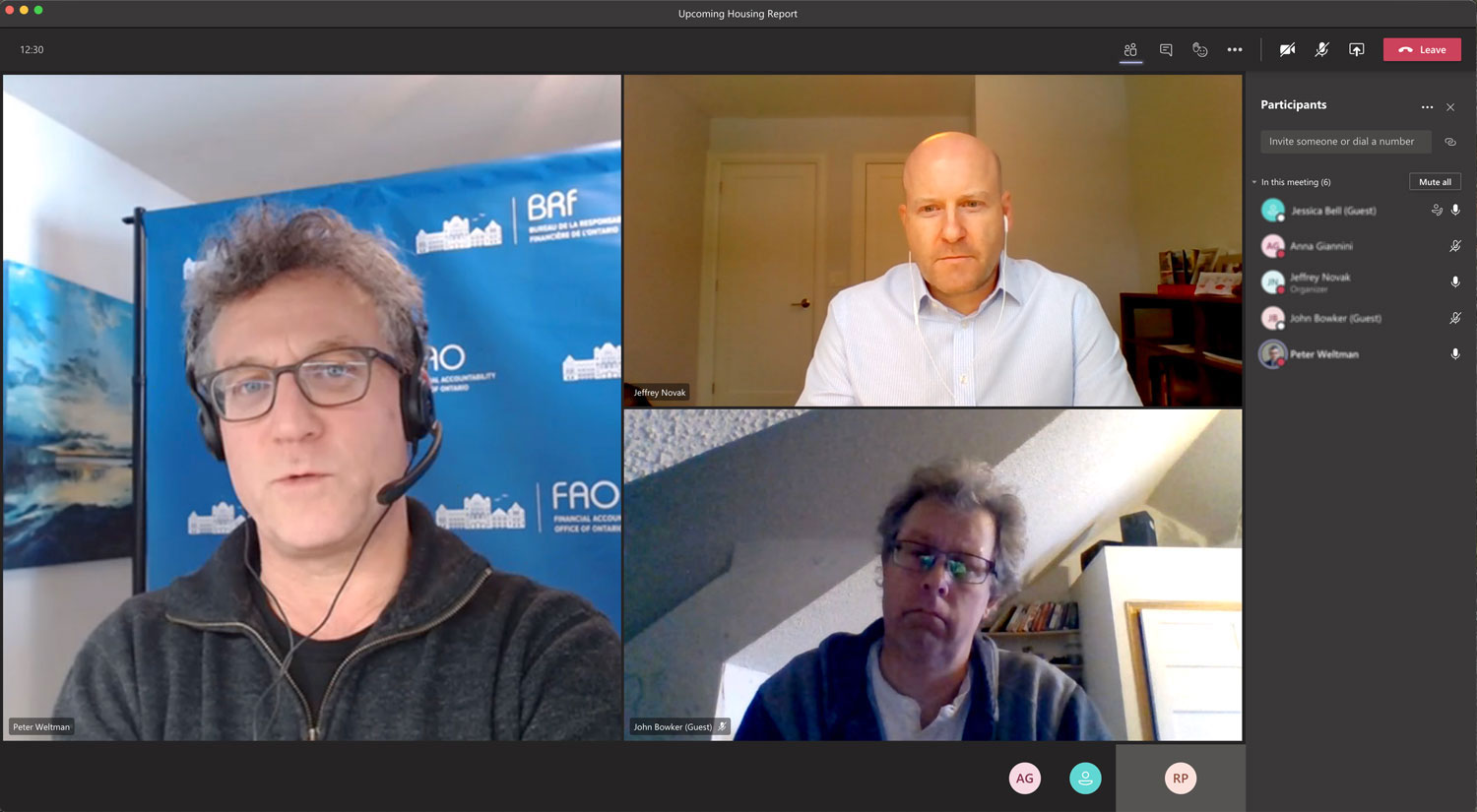
Informal briefings: (left) Peter Weltman and the FAO team discussing tax revenue and growth with MPP Mitzie Hunter and Brendan Knight; and (right) housing with MPP Jessica Bell (not visible, on audio) and John Bowker.
A review of the Province’s new program to lower electricity costs for industrial and large commercial ratepayers. The report found that over the life of the program, from 2020-21 to 2039-40, the total estimated net cost to the Province is $15.2 billion.
In addition to these reports, the FAO delivered two notable presentations in 2020-21. The first presentation marked the first time since the FAO was established in 2015 that it was called to appear before and deliver a presentation to the Standing Committee on Finance and Economic Affairs. The presentation examined the Province’s current fiscal position, economic outlook, and impacts from the pandemic.
The FAO was also asked to appear before Ontario’s Long-Term Care COVID-19 Commission, to provide a briefing of its October 30, 2019 review of the Province’s July 2018 commitment to add 15,000 new long-term care beds by 2023-24.
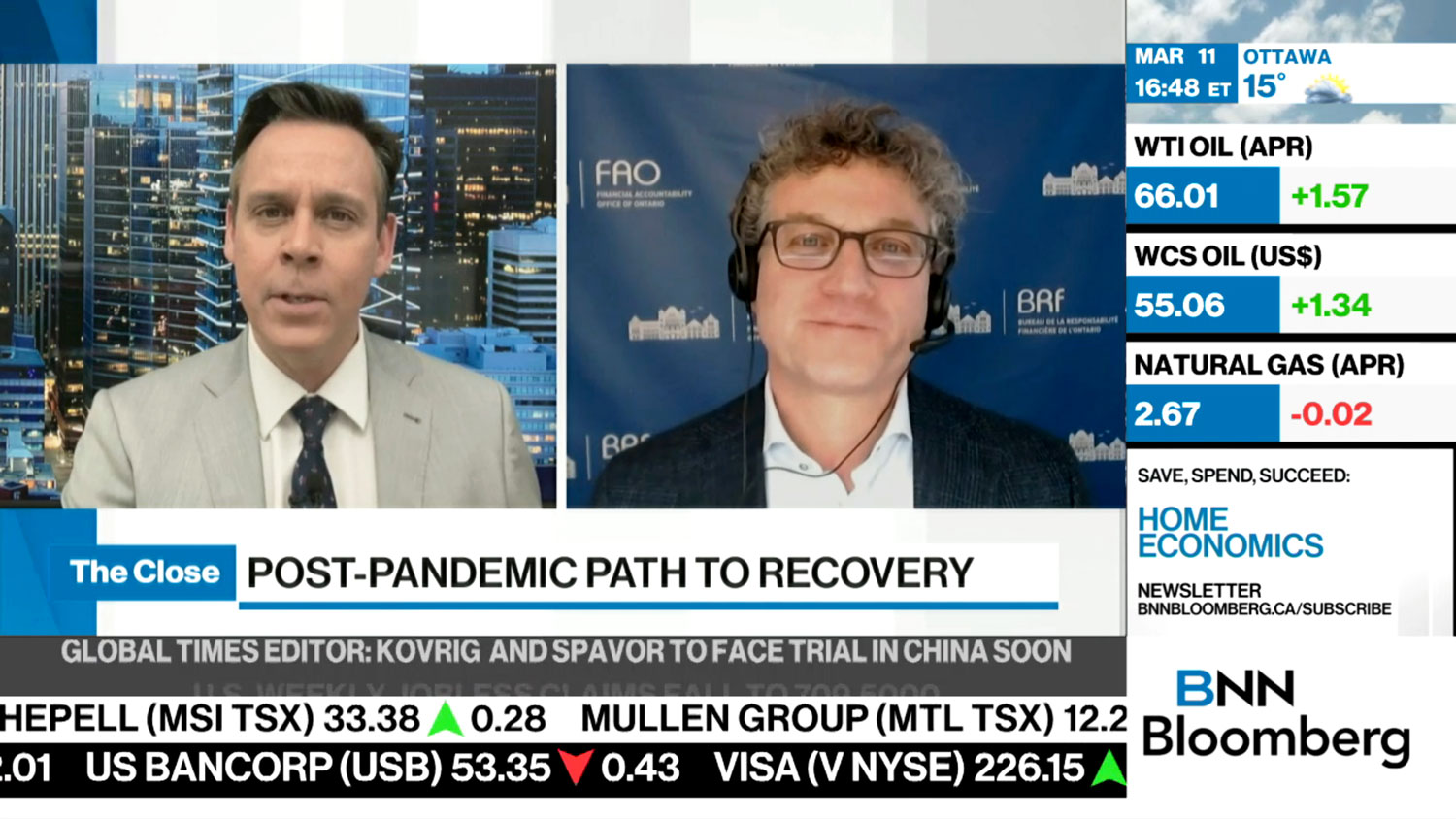
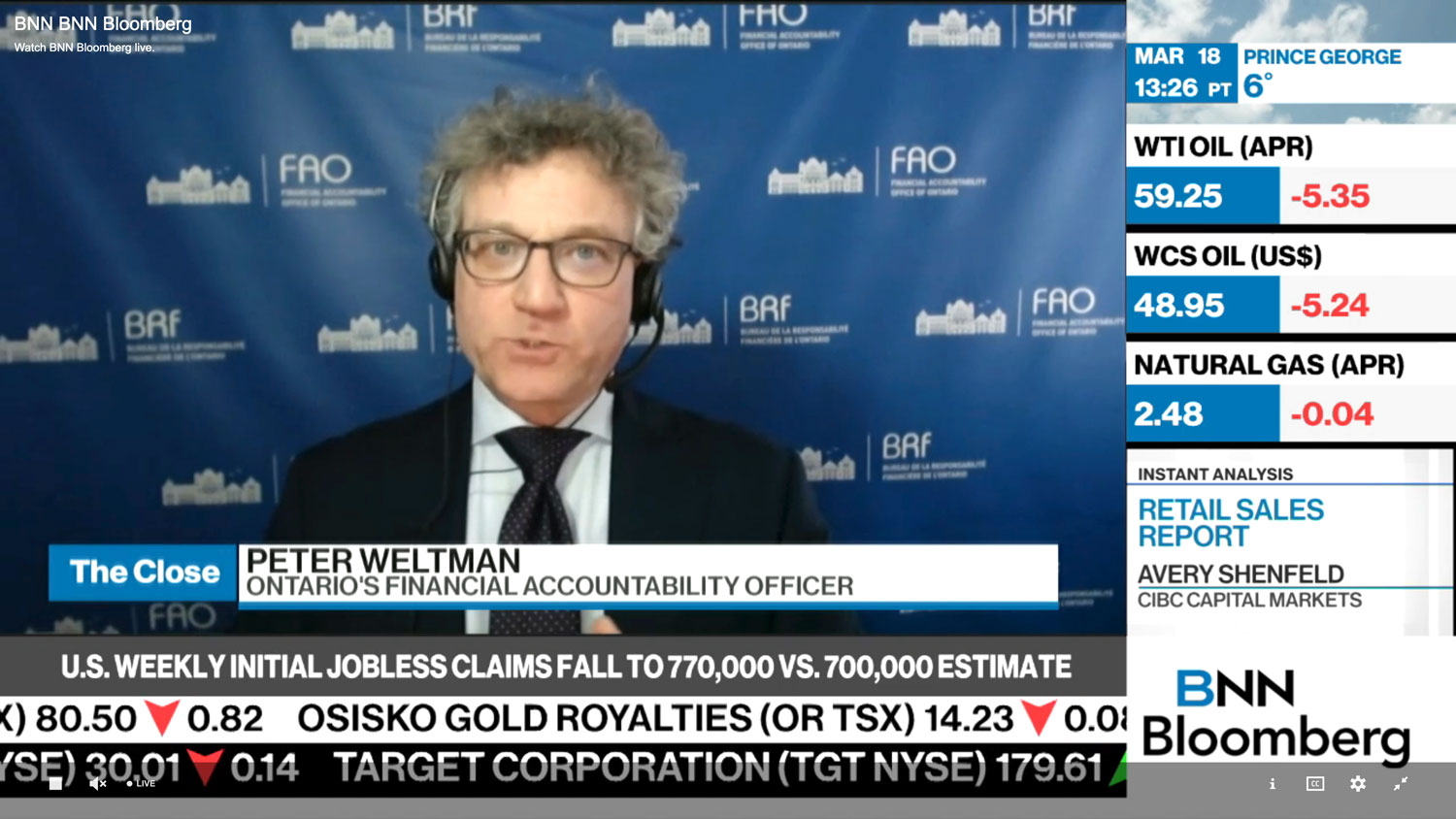

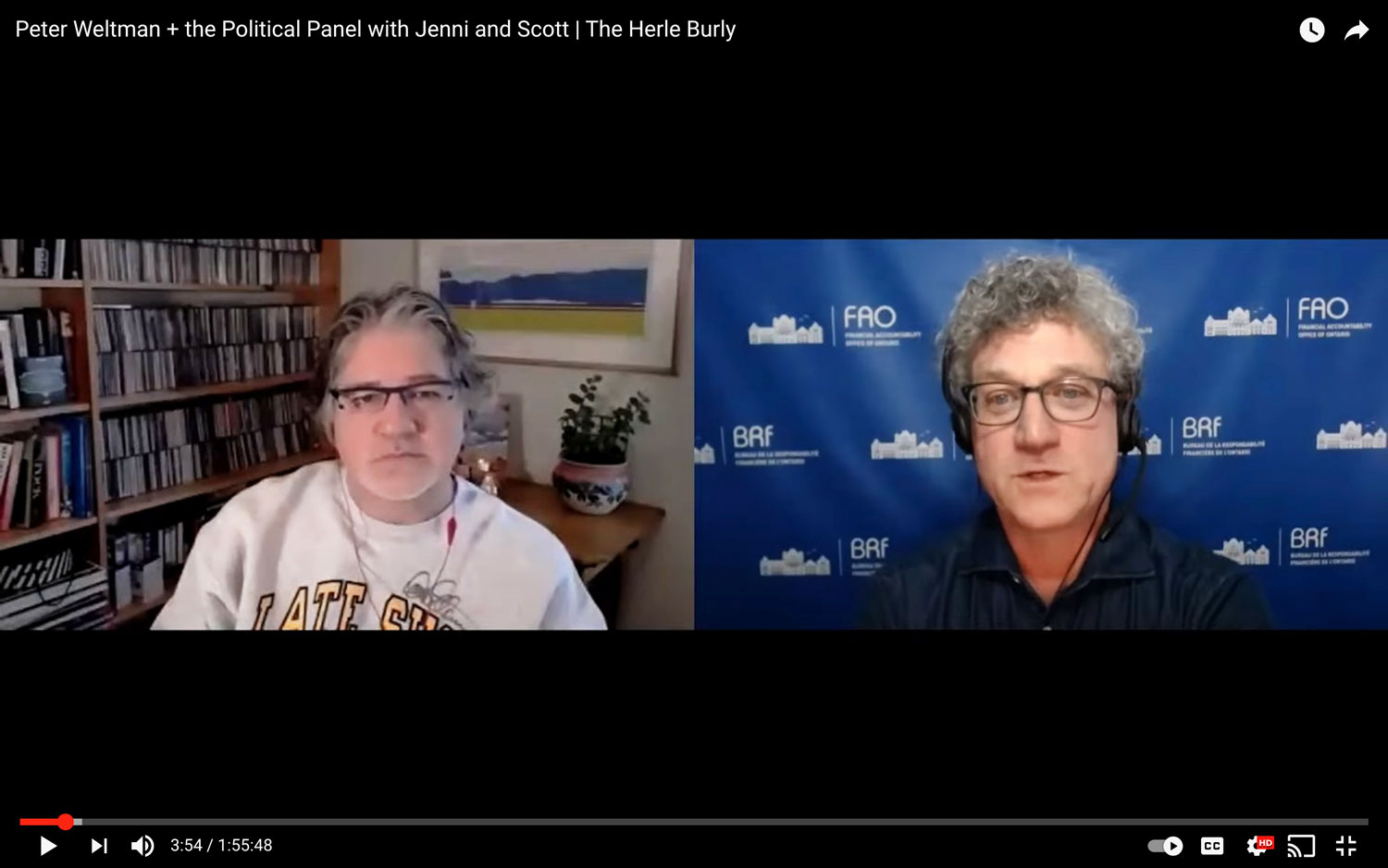

Media appearances by Peter Weltman on (top) BNN Bloomberg’s The Close with Greg Bonnell, (middle) TVO’s The Agenda with Nam Kiwanuka, (bottom left), The Herle Burly with David Herle and (bottom right) BNN Bloomberg’s Breaking News with Andrew Bell.
Use of the FAO’s work
Overview
The FAO’s mission is to enhance legislative debate in Ontario by providing MPPs, committees, media and the public with relevant, authoritative and timely information on the financial impact of government policies. To determine the effectiveness of its reports, the FAO tracks key metrics including mentions in the Ontario Legislature, media coverage and conversations on social media platforms.
In 2020-21, the FAO was mentioned 164 times in the Ontario Legislature, for an average of two mentions per sitting day. There were over 7,600 FAO mentions in news articles and broadcasts and 52 media interview requests. Although the FAO’s website hits decreased by approximately six per cent compared to the previous year, the average time a user spent on a webpage increased by almost 11 per cent. On Twitter, the FAO received 982 mentions, a nine per cent increase from the previous year.
Requests from MPPs and Committee
The FAO may undertake research for both MPPs and committees when requests fall under the FAO’s mandate and the FAO has available research capacity.
In 2020-21, the FAO received 22 research requests from MPPs and two committee requests, resulting in 11 reports responding to MPP requests and one report responding to a committee request. The remaining requests were either moved to subsequent years or unfulfilled due to increasing demands for the FAO’s limited resources. While the FAO will not disclose the source of a request, an MPP or committee is free to identify themselves as they wish.
MPP Engagement
In 2019-20, the FAO commissioned two MPP surveys to better understand its effectiveness and gain new insights into how its engagement strategy could be improved.
The MPP surveys provided the FAO with important insights that have helped guide the office’s new engagement strategy. This year the FAO produced 31 explainer videos and 45 infographics that highlighted key takeaways from each report. Additionally, the FAO developed seven “Fiscal Fridays” social media posts to help improve fiscal and economic literacy among MPPs and their constituents. The FAO’s enhanced engagement strategy aims to increase awareness of the office’s work and support the FAO’s objective of being the trusted source for provincial fiscal and economic analysis.
Access and Disclosure of Information
Access to Information
Access to government information is a key requirement of the FAO’s work, forming the base content for economic and fiscal analysis in support of the Legislative Assembly. In 2020-21, the FAO maintained its professional working relationship with the executive branch, including ministries, deputies and public entities, with each helping to provide the FAO with timely access to all necessary information as legally required. Ministries and public entities have a statutory duty to provide the FAO with information that the Officer believes necessary to perform his mandated duties, subject to only limited exceptions. In addition, two orders in council provide the FAO with access to certain information contained in Cabinet records from the current Executive Council, presided over by Premier Ford, and the previous Executive Council, presided over by former Premier Wynne.
Without access to government information, especially Cabinet records, the FAO could not operate at current levels, both in terms of number of reports produced and the quality of analysis in many of its reports. As such, it is important that all MPPs understand the relevance and value that this information brings to the legislature’s ability to hold the government to account.
Disclosure of Information
Although the FAO has access to a wide range of information, the Financial Accountability Officer Act, 2013, and the orders in council place important restrictions on the FAO’s ability to disclose government information.
Accordingly, the FAO has put in place internal processes that ensure information subject to these restrictions is not disclosed. As part of these processes, ministries and public entities provide advice to the FAO, which helps ensure that the FAO complies with its disclosure restriction obligations.
Financial Statement
Financial figures are rounded to the nearest dollar and are prepared on a modified cash basis. The figures for 2017-18 through 2019-20 are from the Public Accounts of Ontario.
| 2020-21 $ (Unaudited) | 2019-20 $ (Unaudited) | 2018-19 $ (Unaudited) | 2017-18 $ (Unaudited) | |
|---|---|---|---|---|
| Approved Budget | 3,850,000 | 3,711,000 | 3,384,000 | 3,255,000 |
| One-time transfer* | 88,000 | 16,791 | ||
| Expenditure | ||||
| Salaries and wages | 2,736,481 | 2,383,145 | 1,827,927 | 1,658,914 |
| Employee benefits | 518,913 | 397,639 | 327,273 | 305,845 |
| Transportation and communication | 9,225 | 17,076 | 41,915 | 19,796 |
| Services | 644,889 | 873,536 | 727,558 | 542,238 |
| Supplies and equipment | 28,111 | 56,395 | 76,421 | 39,269 |
| Total Expenditure | 3,937,619 | 3,727,791 | 3,001,094 | 2,566,062 |
| Unused Appropriation | 381 | 0 | 382,906 | 688,938 |
The Year In Review

The infographic provides a summary of performance metrics for 2020-21. The FAO produced 24 reports in 2020-21, five more than the previous year. The website had a total of 169,717 views, approximately 6% less than 2019-20. The top five most viewed reports were (starting with the top viewed): 1) Ontario Health Sector: A Preliminary Review of the Impact of the COVID-19 Outbreak on Hospital Capacity with 12,873 hits; 2) Federal and Provincial COVID-19 Response Measures with 4,667 hits; 3) Economic and Budget Outlook, Spring 2020 with 3,602 hits; 4) Ontario’s Job Market During the COVID-19 Pandemic with 2,428 hits; and5) Autism Services with 2,184 hits. In the media, the FAO was featured 7,610 times in 2020-21 compared to 3,695 hits in 2019-20. Our email subscribers grew to 736, up from 530. The FAO held 16 technical briefings for MPPs and 76 stakeholder meetings. On average, the FAO was mentioned twice per sitting day at the legislature. Financial Accountability Officer, Peter Weltman, partook in 52 media interviews in 2020-21, 17 more than in 2019-20. The FAO created 45 infographics in 2020-21 compared to 5 in 2019-20.
On Twitter, the FAO was mentioned 982 times in 2020-21 compared to 902 times in 2019-20. Twitter followers increased to 1,370 from 1,159. Twitter engagements increased to 5,501 from 2,997 and impressions increased to 274,000 from 190,792. On LinkedIn, the FAO’s followership stood at 278 at the end of 2020-21, it had received 852 engagements, and it had 15,882 impressions.




